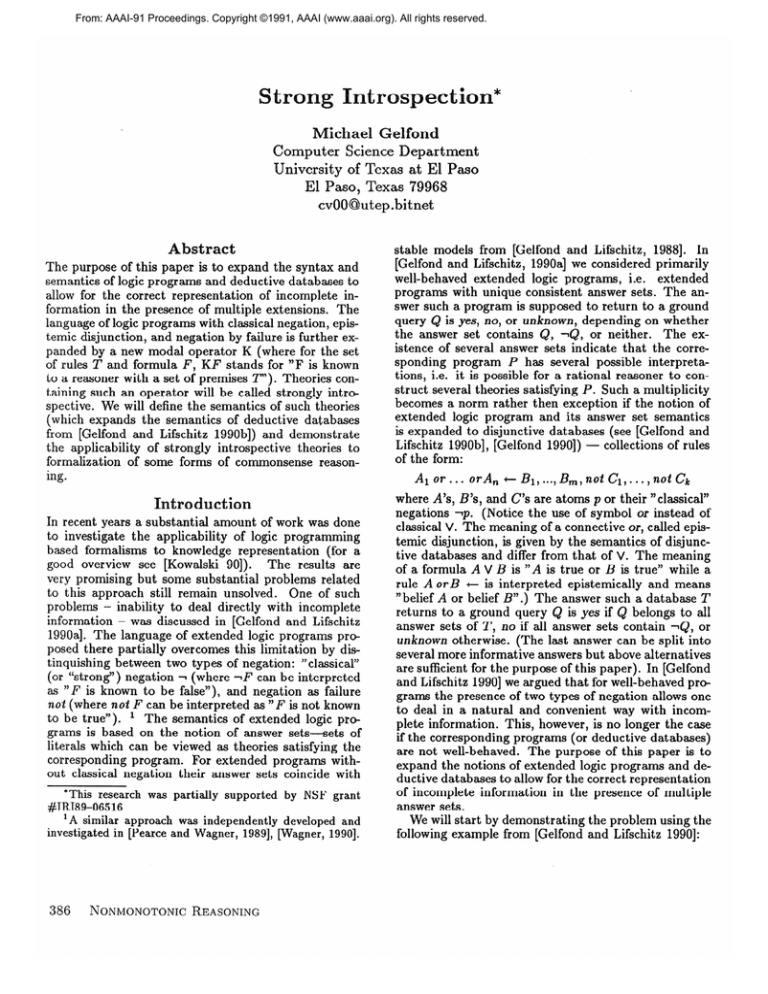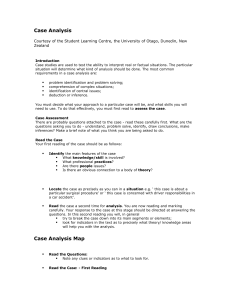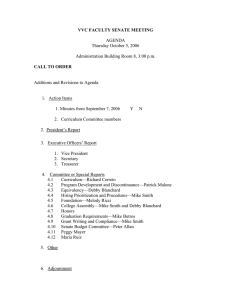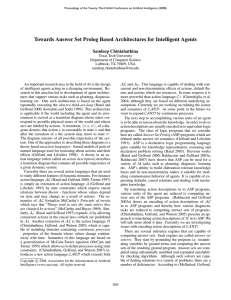
From: AAAI-91 Proceedings. Copyright ©1991, AAAI (www.aaai.org). All rights reserved.
Michael Gelfond
Computer Science Department
University of Texas at El Paso
El Paso, Texas 79968
cvOO@utep.bitnet
Abstract
The purpose of this paper is to expand the syntax and
semantics of logic programs and deductive databases to
allow for the correct representation
of incomplete
information
in the presence of multiple extensions.
The
language of logic programs with classical negation, epistemic disjunction,
and negation by failure is further expanded by a new modal operator K (where for the set
of rules T and formula F, KF stands for “F is known
to a reasoner with a set of premises 7”‘). Theories containing such an operator will be called strongly introspective. We will define the semantics of such theories
(which expands the semantics
of deductive
databases
from [Gelfond and Lifschitz 199Ob]) and demonstrate
the applicability
of strongly introspective
theories to
formalization
of some forms of commonsense
reasoning.
Introductisn
In recent years a substantial
amount of work was done
to investigate
the applicability
of logic programming
based formalisms
to knowledge
representation
(for a
good overview see [Kowalski 901).
The results are
very promising but some substantial
problems related
to this approach still remain unsolved.
One of such
problems - inability
to deal directly with incomplete
information
- was discussed in [Gelfond and Lifschitz
199Oa]. The language of extended logic programs proposed there partially overcomes this limitation
by distinquishing
between two types of negation:
“classical”
(or “strong”) negation 1 (where 1F can be interpreted
as “F is known to be false”), and negation as failure
not (where not F can be interpreted
as “F is not known
to be true”).
’ The semantics
of extended logic programs is based on the notion of answer sets---sets
of
literals which can be viewed as theories satisfying the
corresponding
program.
For extended programs without classical negation
their answer sets coincide with
*This research
was partially
supported
#IRI89-06516
‘A similar approach
was independently
investigated
in [Pearce and Wagner,
19891,
386
NONMONOTONIC
REASONING
by
NSF
grant
developed
and
[Wagner, 19901.
stable models from [Gelfond and Lifschitz, 19881. In
[Gelfond and Lifschitz, 199Oa] we considered primarily
well-behaved
extended
logic programs,
i.e. extended
programs with unique consistent
answer sets. The answer such a program is supposed to return to a ground
query Q is yes, no, or unknown, depending
on whether
the answer set contains Q, l&, or neither.
The existence of several answer sets indicate that the corresponding
program
P has several possible interpretations, i.e. it is possible for a rational reasoner to construct several theories satisfying P. Such a multiplicity
becomes a norm rather then exception if the notion of
extended
logic program and its answer set semantics
is expanded to disjunctive
databases
(see [Gelfond and
Lifschitz 1990b], [Gelfond 19901) - collections of rules
of the form:
Al or . . . orA,
+ B1, . . . . B,,not
Cl,...,not
Ch
where A’s, B’s, and C’s are atoms p or their “classical”
-p. (Notice the use of symbol or instead of
negations
classical V. The meaning of a connective or, called epistemic disjunction,
is given by the semantics of disjunctive databases and differ from that of V. The meaning
of a formula A V B is “A is true or B is true” while a
rule A orB t is interpreted
epistemically
and means
“belief A or belief B”.) The answer such a database T
returns to a ground query Q is yes if & belongs to all
answer sets of T, no if all answer sets contain l&, or
unknown otherwise.
(The last answer can be split into
several more informative
answers but above alternatives
are sufficient for the purpose of this paper). In [Gelfond
and Lifschitz 19901 we argued that for well-behaved
programs the presence of two types of negation allows one
to deal in a natural
and convenient
way with incomplete information.
This, however, is no longer the case
if the corresponding
programs (or deductive databases)
are not well-behaved.
The purpose of this paper is to
expand the notions of extended logic programs and deductive databases to allow for the correct representation
of incomplete
information
in the presence of multiple
answer sets.
We will start by demonstrating
the problem using the
following example from [Gelfond and Lifschitz 19901:
Example 1 Considered
1.
2.
3.
4.
a collection
of rules
Eligible(x) t High GPA(x) ,
Eligible(x) t Minority(x), FairGPA(x),
t -FairGPA(x),
-Eligible(x)
Interview(x) c
not Eligible(x),
not -Eligible(x)
used by a certain college for awarding scholarships
to
its students.
The first three rules are self explanatory
while the fourth rule can be viewed as a formalization
of the statement:
(*) “The students
whose eligibility
is not determined
by the first three rules should be interviewed
by the
scholarship committee”.
In its epistemic form the rule says : Interview(x),
if neither Eligible(x) nor 1 Eligible(x) is known. We assume
that this program is to be used in conjunction
with
a database DB consisting
of literals specifying values
of the predicates
Minority, HighGPA, FairGPA. Consider, for instance,
DB consisting of the following two
facts about one of the students:
5. FairGPA(ann)
6. -HighGPA(ann)
+.
t.
(Notice that DB contains no information
about the minority status of Ann). Intuitively
it is easy to see that
rules (l)-(6) a 11ow us to conclude neither Eligible(unn)
nor lEligible(ann),
therefore eligibility of Ann for the
scholarship is undetermined
and, by rule (4), she must
be interviewed.
Formally this argument
is reflected by
the fact that program Ti consisting of rules (l)-(6) has
exactly one answer set:
(FairGPA(ann),
-HighGPA(ann),
Interview(ann)).
The situation
changes significantly
if disjunctive
information
about students
is allowed to be represented
in the database.
Suppose, for instance, that we need to
augment rules (l)-(3) by the following information:
(**) Mike’s GPA is fair or high.
There are several possible ways to represent
this information.
The most natural
one seems to be to use
the language and semantics of deductive databases from
[Gelfond and Lifschitz, 1990b]. The corresponding
deductive database Ts consists of rules (l)-(3) augmented
by the disjunction
7. FairGPA(mike)
T2 has two answer
or HighGPA(mike)
t
sets:
Al = { HighGPA(mike),
Eligible(mike))
and
A:! = { FairGPA(mike)},
and therefore the reasoner modeled by Tz does not have
enough information
to establish
Mike’s eligibility
for
is unthe scholarship
(i.e. answer to Eligible(mike)
known). If we now expand this theory by (*) we expect
the new theory T3 to be able to answer yes to a query
Interview(Mike).
It is easy to see however that if (*)
is represented
by (4) this goal is not achieved. The resulting theory Ts consisting of (l)-(4)
and (7) has two
answer sets
A3 = (HighGPA(mike),
Aa = (FairGPA(mike),
Eligible(mike))
Interview(mike))
and therefore the answer to query Intervieufmike)
is
unknown. The reason of course is that (4) is too weak
to represent (*). The informal argument
we are trying
to capture goes something
like this: theory T3 answers
neither yes nor no to the query Interview(mike).
Therefore, answer to this question is undetermined,
and, by
(*), Mike should be interviewed.
To formalize this argument our system should have a more powerful introspective ability then the one captured by the notion of answer sets from [Gelfond and Lifschitz 1990b]. Roughly
speaking instead of looking at only one possible set of
beliefs sanctioned
by T it should be able to look at all
such sets.
&mark.
The situation will not change if (**) is represented by modeling disjunctions
in the language of logic
programs.
For instance, replacing (7) by two rules
FuirGPA( Mike)
HighGPA(Mike)
will not change
answer
t
not HighGPA(Mike)
t
not FairGPA(Mike)
sets of the program.
In this paper we extend the syntax of deductive
databases
from [Gelfond and Lifschitz 1990b] in two
Firstly, following [Lloyd and Topor 19841,
directions.
and [Wagner 19901 we allow the rules to contain other
types of formulae except literals.
Secondly, and more
importantly,
we expand the language by a modal operator K (where for any set of rules T and formula F, KF
stands for “F is known to a reasoner with a given set
of premises T”). Theories containing
such an operator
will be called strongly introspective.
We will define the
semantics of such theories (which expands the semantics of deductive databases from [Gelfond and Lifschitz
1990b] and demonstrate
the applicability
of strongly introspective
theories for formalization
of some forms of
commonsense
reasoning.
Definitions
Let us consider a language & consisting
of predicate
function
symbols,
symbols p, q, . . ., object variables,
logical connectives
&, 1, not, 3, and the modal operator K. Formulae of & will be defined in the usual way.
Formulae not containing
modal operators will be called
objective formulae while those starting
with K will be
Formulae of the form p(a) will be
called subjective.
called objective
atoms.
By objective
literals we will
GELFOND
387
mean objective atoms p(a) and their strong negations
-p(u).
Literals not containing
variables will be called
ground.
The set of all ground literals will be denoted
by Lit. Formulae not containing
free variables will be
called statements.
Let us consider a collection A = (Ai} of sets of ground
objective literals and a set W of such literals.
(A can
be thought of as a collection of possible belief sets of a
reasoner while W represents his current (working) set of
beliefs.) We will inductively
define the notion of truth
(= ] ) of formulae of -Ge w.r .t. a pair
($) a.~: f$$y
=
*
1
Definition
1
M b KF i$ < A, Ak >b F for every Ak from A
MbF&GiflMbFandMbG
M /= 3xF iff there is a ground term t such that
M I= F(t)
M b=F
i$M=IF
MbnotF
iffMkF
M =Ip(a) iff -p(a) E W
M =I KF #<
A, An: >=I F for some & from A
M =(F&G i$M =(F orM=(G
M =I 3xF iff for eve y ground term t, M =I F(t)
M=I-FiffM#=F
M=InotF
i’M+F
It is easy to see that according to this definition the
truth of subjective
sentences
does not depend on W
while the truth of objective ones does not depend on
A, i.e. we have a notion of objective formula being true
(false) in W and subjective
formula being true (false)
in A. We will denote the former by W b F (W =I F)
and later by A b F (A =I F).
In our further discussion we will expand language .Ce
by the connectives
or and V and a modal operator M
(where MF will be read as “F may be believed”) defined
as follows:
MF iff 1KlF
F or G iff 7(-F
VxF iff 13xlF
Definition
2 By an epistemic
specification
mean a collection of rules of the form
we will
and G’s are arbitrary formulae.
NONMONOTONIC
REASONING
specification
con-
F+
A set W of liter& is called a belief set of To iff W
is a minimal set with a property W b F for every rule
from To. If W contains a pair of complementary
literals
then W = Lit.
Example 2 Let T consist
of clauses:
1. P(Q) 01‘P(b) c
2. -p(b) +
3. not q(b) t
4. r(a) or lr(b)
5. 32q(x) +
t
It is easy to see that T has two belief sets:
(p(a), -P(b),
q(a)9 r(o))
(p(o), -p(b),
q(a), -r(b))
Definition 4 Let T be an arbitrary epistemic specification, W be a set of litenrls in the language of T and
A be a collection of sets of liter& in this language. For
every M = < A, W > by TM we will denote the epistemic specification obtained from T by:
1. Removing from the premises
lae G such that M k G.
2. Removing
all remaining
premises.
of rules of T all formurules
with
non-empty
Then A will be called a world view of T i$ A = (W :
W is a belief set of TM) where M =< A, W >.
Example 3 Let T consist
or P(b) c- 3x&(x),
of the formulae
not Q(d)
2. Q(c) +
F + G1,...,G,,.,
388
Definition 3 Let To be an epistemic
sisting of rules of the form
1. P(a)
& ~6)
The language and the satisfiability
relation described
above together with the notion of a rule from logic programming will be used to provide a specification
of a
reasoner with the desired properties.
(This view on the
role of logic in nonmonotonic
reasoning seems to be similar to the one advocated
by H. Levesque in [Levesque
901). The formal notion of such a specification
is captured by the following definitions:
where F is objective
Now we will define a collection A of sets of literals
(which can be viewed as vivid theories in terminology
from [Levesque SS]) satisfying an epistemic specification
T. We will call such a collection a world view of T and
its elements belief sets of T. The precise definition
of
these notions will be given in several steps:
It is easy to see that this specification
has a unique
world view consisting of two belief sets (Q(c),
P(a))
and {Q(c), WI.
Example 4 Let T consist
1.
2.
3.
4.
of the formulae
Paor Pb+Pet
&Cat
~Px + not MPx
It is easy to show that
A = ( {Qd, Pa, Pc,lPd},
(Qd, Pb, PC,-Pd}}
is the only world view of T.
Example 5 Let T consist
of the formulae
1.
2.
3.
4.
Pa+
Qbor
Rx t
Sx t
Applications
&cc
not K&x
not M&x
In this section we will discuss several applications
of
epistemic
specifications
to formalization
of commonsense reasoning.
The only world view of T is
A = {(Pa, Qb, Ra, Rb, Rc, Sa},
(Pa, Qc, Ra, Rb, Rc, Sa}].
Example 6 Let T = {p t not Kp}.
that T does not have a world view.
(a) Representing the Unknown.
It is easy to see
Example 7 Let
T = {p + not M q, q t not M p}. This specification
is satisfied by two world views: Al = {(q}} and A2 =
{{P11*
Definition 5 We will say that a world view of epistemic specification T is consistent if it does not contain
a belief set consisting of all laterals.
Definition 6 We will say that epistemic specification
is consistent if it has at least one consistent world view.
Example 8 Let T consist of formulae p and -p.
It
is easy to see that theory T is inconsistent.
Another
inconsistent
specification
is given in Example 6.
Definition 7 A specification is called well-defined if
it has exactly one consistent world view.
Prom now on we will only consider
ifications.
well-defined
spec-
Definition 8 Let T be a specification and A = {Ai} be
its world view. A formula F is true in T (T b F) ifl
< A, Ai >b F for every Ai from A.
This definition
can be used to define the range of
possible answers to a query Q. For the purpose of this
paper we will limit ourself to the simple case when answer to Q is yes if T b Q, no if T k l&, and unknown
otherwise.
The following two Propositions
establish the relationship between deductive databases
and epistemic specifications.
Proposit ion 1. Let T be an epistemic
consisting of clauses of the form
F + G1,... ,G,, not E,,,+l, . . . , not Ek.
Then
specification
1. If F, G’s and E’s are atoms (i.e. T is a general logic
program) then A is a world view of T iff A is the set
of all stable models of T.
2. If G’s, and E’s are objective literals and F is a disjunction
of objective literals (i.e. T is a deductive
database) then A is a world view of T iff A is the set
of all answer sets of T.
Proposition 2. Let T be a well-defined specification
with the world view A. Then A is a singleton iff W E A
is the unique answer set of the theory T’ obtained from
T by deleting modal operators K and M.
We will start with demonstrating
how statements
of
the form “unknown
p” can be represented
by strongly
introspective
formulae. We suggest to represent formulae of this form as a conjunction
of formulae not K p
and not K lp. Let us go back to Example 1 from the
introduction
to illustrate
this point.
Example 1 revisited. Let us consider the theory consisting of rules (l)- (3) and (7) from Example 1. To obtain the proper formalization
of (*) we will just replace
statement
(4) by
4’. Interview(x)
t
not K Eligible(x),
not K -Eligible(x)
which corresponds
closely to the intuitive
meaning
(*). It is easy to check that the theory T consisting
rules (l)-(3),
4’, and (7) has the world view
A = (Al,As}
where
Al = { HighGPA(Mike),
Eligible(Mike),
A2 = (FairGPA(Mike),
of
of
Interview(Mike)}
Interview(Mike))
unknown
to
the
query
Therefore
T
answers
Eligible(Mike)
and yes to the query Interview(Mike)
which is the intended behaviour of the system.
(b) Closed World Assumption.
Now we will illustrate how strong introspection
can be
used to represent the Closed World Assumption
(CWA)
of [Reiter 19781 for non-Horn databases
(i.e. databases
containing
disjunctions).
The question of formalizing
this assumption
has been extensively studed by various
authors (for a good review see [Przymusinska
and Przymusinski 19901). [Minker I9821 gives perhaps the most
widely known form of the CWA for non-Horn databases.
As was noticed in [Ross and Topor 19881, this assumption tends to interpret
disjunction
as exclusive.
Some
attempts to remedy this problem can be found in [Chan
891, [Sakama 891 and [Gelfond 901. Pull discussion of
these and other approaches is beyond the scope of this
paper.
Instead,
we suggest a formalization
of CWA
that we believe is more general. We will start with the
following example:
Example 9. [Chan
following information:
891.
Suppose
we are given
the
(*) “If suspect is violent and is a psychopath
then the
suspect is extremely dangerous.
This is not the case if
the suspect is not violent or not a psychopath”
which is used in conjunction
sisting of literals specifying
with a database DB convalues of the predicates
GELFOND
389
violent and psychopath.
Let us also assume that DB
contains
complete
positive
information
about
these
predicates,
i.e. ground atoms with predicate symbols
violent and psychopath assumed to be false if there is no
evidence to the contrary. This statement
can be viewed
as an informal description
of Reiter’s Closed World Assumption (CWA).
The information
from (*) can be easily expressed by
three statements
1. dangerous(x)
2. -dangerous(x)
3. -dangerous(x)
+ not P(x)
As expected this formalization
works nicely for welldefined extended
programs
but is not suitable in the
general case.
To see the problem
let us apply this
idea to our example.
CWA for predicates
violent and
psychopath will look as follows:
4. -violent(x)
+ not violent(x).
5. -cpsychopath(x)
+ not psychopath(x)
that
our DB contains
6. violent(john)
t,
7. violent(mike)
t,
8. psychopath(mike)
the following
informa-
t.
It is easy to check that the theory Tl consisting
of
clauses (l)-( 8) is well-defined and has exactly one belief
set Ao:
(violent(john),
violent(mike),
psychopath(mike),
-psychopath(john),
-dangerous(john),
dangerous(mike))
It is easy to see that for well-defined
formalizations
of CWA coincide.
which properly
reflects our intuition.
The situation
changes when disjunctive
information
is allowed in DR.
Consider, for instance. a statement
9. violent(sam)
both
from T2 by
(c) Integrity Constraints
We will finish our discussion of applicability
of strong
introspection
to formalization
of commonsense
reasoning by an example demonstrating
the utility of strong
introspection
for expressing integrity constraints.
Example 10. Let us assume that we are given the
specification
for a departmental
database T:
(a) T should contain lists of professors, courses and
teaching
assignments
for a CS department.
Let us
first assume that the department
consists of professors
named Sam and John and offers two courses:
Pascal
and Assembler, taught by Sam and John respectively.
(b) The above lists contain all the relevant positive
information
about the department
known to us at a
_
time.
(c) T must satisfy the following integrity constraint:
Pascal is taught by at least one professor.
(a) of the specification
is formalized
I. proj(sam) & proj(john)
+
2. class(pasca1) & class(assembler)
3. teach(sam, Pascal) & teach(john,
as follows:
+assembler)
+
,
or psychopath(sam)
and a specification
T2 consisting of clauses (l)-(5)
and
(9). Notice that (9) is not an exclusive disjunction
and
therefore T2 does not seem to sanction the conclusion
10. Idangerous(sam).
But it is easy to see that T2 does imply (10) which
seems to be overly optimistic.
The problem is apparently caused by an incorrect formalization
of CWA the fact that not violent(sam)
is true in one of the belief
sets of T2 does not guarantee
that, given T2, a rational
reasoner does not have a reason to belief violent(sam).
390
programs
The resulting theory has exactly one world view A consisting of two belief sets Al = A0 U {violent(sam)}
T3 implies neiand A2 = Ao U (psychopath (Sam)}.
ther (10) nor its negation and therefore answer to the
query dangerous(sam)
is unknown.
Part
I
+ not MP(x)
+ not Mviolent(x).
4’. -violent(x)
5’. -psychopath(x)
t not Mpsychopath(x)
Formalization
of CWA is somewhat more problematic.
In [Gelfond and Lifschitz 19901 we suggested to express
CWA for a predicate P(x) by the rule
Suppose
tion:
lP(x)
Let us now consider theory T3 obtained
replacing statements
(4) and (5) by
+ violent(x), psychopath(x)
c- wiolent(x)
t -psychopath(x)
-P(x)
In the case of T2 such reason may be given by the existence of a belief set containing
violent(sam).
This consideration leads us to the better representation
of CWA
for a predicate P which is provided by the statement
NONMONOTONIC
REASONING
Part (b) of the specification
can be viewed as the Closed
World Assumption
and represented
as
4. -P(x)
+ not MP(x)
for every predicate
symbol
P.
Formalization
of part (c) seems to be the less obvious task.
The main difficulty is related to the lack
of universally
excepted interpretation
of the meaning
and role of integrity constraints
in knowledge represenIn this paper we will adopt the view on inCation.
tegrity constraints
recently suggested by Reiter in [Reiter 19901. According to Reiter an integrity constraint
IC is a statement
about the content of the knowledge
base T (as opposed to IG being a statement
about the
world). T satisfies IC iff the answer to IC when viewed
as a query to T is yes . A simple analysis of clause (c)
from this standpoint
shows that (c) can be interpreted
in two different ways:
ICI : K 3p(proj(p)
or
I&
& teach(p,pascal))
: 3p K (proflp) & teach(p,pascal))
The first one says that the database knows that Pascal
is taught by some professor (whose name can be unknown to the database),
while the second one means
that there is a person known to the database
to be
a professor teaching Pascal.
It is easy to see that Ti
consisting of rules (l)-(3)
satisfies both integrity constraints.
If however, we consider T2 obtained from Tl by replacing rule 2 by
2’. teach(sam,
the situation
Pascal) or teach( john, Pascal)
changes.
It is easy to check that T2 satisfies ICI but not IC2.
This is of course the intended result since this time the
database does not know what professor will teach Pascal
but knows that Pascal will be taught.
Remark.
Even though the approach to formalization
of integrity constraint
suggested in this paper is similar
to the one of Reiter there are some important
differences: Reiter views a knowledge base as a first-order
theory and a query as a statement
of Levesque’s modal
logic (called KFOPCE).
I n our case knowledge base and
queries are both epistemic formulae while the underlying logic is nonmonotonic.
Acknowledgments
I am grateful to Vladimir Lifschitz and Halina Przymusinska for comments on the first draft of this paper.
eferences
[Chan 19891 E. Ch an, A Possible World Semantics for
Non-Horn Databases,
Research Report CS-89-47, University of Waterloo, Waterloo, Ontario, Canada, I989
[Gelfond 19901 M. Gelfond, Epistemic Approach to Formalization
of Commonsense
Reasoning,
Research Report, University of Texas at El Paso, 1990
[Gelfond and Lifschitz 19881 M. Gelfond and V. Lifschitz, The Stable Model Semantics for Logic Programs,
Proceedings
of the Fifth International
Conference
and
Symposium
on Logic Programming,
(Kowalski,
R.A.
and Bowen, K.A. editors), vol. 2, pp. 1070-1080, 1988
[Gelfond and Lifschitz 1990b] M. Gelfond, V. Lifschitz,
Classical Negation in Logic Programs
a
Databases,
Research Report, University
Q
Paso and Stanford University,
1990
[Kowalski 901 R. A. Kowalski, Problems and Promises
of Computational
Logic, Proc. Symposium
on Computational Logic, Springer-Verlag,
1990
[Levesque 19861
Computers,
Artificial
Intelligence
aking Believers out of
30, (1986) pp. 81-108
[Levesque 19901
Levesque, All I Know:
Autoepistemic
Logic, Artificial Intelligence
pp. 263-309
[Lloyd and Topor 19841 J.
Making Prolog More Expressive, Journal
gramming,
I984 : 3, pp. 225-240
A Study in
42, (1990)
of Logic Pro-
ker 19821 J. Minker, On indefinite
databases
and
d world assumption.
In Lecture Notes on Computer Science 138, pg. 292-38, 1982.
ner, Rea[Pearce and
r ‘19891 Pearce, 6.
soning with
e Information
I - St
Negation
in Logic Programming,
Technical Report, Gruppe fur
Logic,
issenstheorie
und Information,
I%eie Universitat Berlin, 1989
[Przymusinska
and
rzymusinski
19901
ska, T. Przymusinski,
Semantic
Issues
Databases
and Logic Programs,
In R.
s in Artificial Intelli
d, Amsterdam,
1990
in Deductive
, editor,
p. 321-
iter, On Closed World Data
J. Minker, editors, Logic an
Bases, pg 119-140, Plenum, New York, 1978.
[Reiter 19901 R. Reiter, On asking what a database
knows, Proc. of Symposium
on Computational
Logic,
Springer-Verlag,
1990
[Ross and Topor 19881 K.Ross, R. Topor, Inferring Negative Information
from Disjunctive
Databases,
Journal
asoning, (4:4), pp. 397-424, 1988
[Sakama 19891 C. Sakama, Possible Model Semantics
for Disjunctive
Databases,
Proceedings
of the first International
Conference
on Deductive
and Object Oriented Databases,
Kyoto, Japan, 1989
[Wagner 19903 G. Wagner,
Logic Programming
Strong Negation and Inexact Predicates,
1990
with
[Gelfond and Lifschitz 199Oa] M. Gelfond and V. Lifschitz, Logic Programs
with Classical Negation,
Proceedings of the Seventh International
Conference
on
Logic Programming,
MIT Press, pp. 579-597, 1990
GELFOND
391







